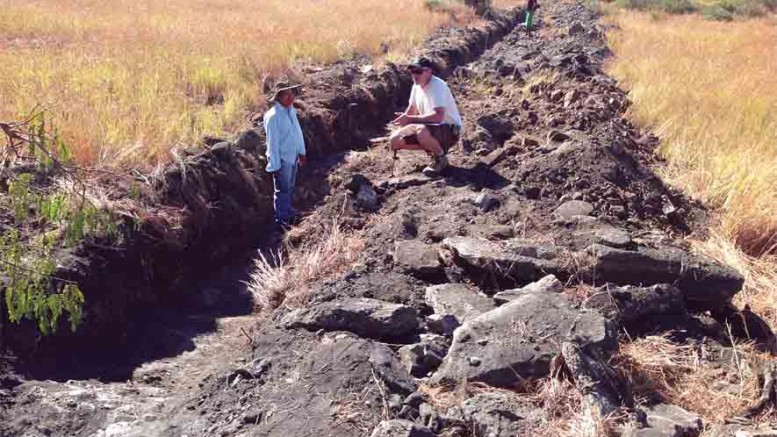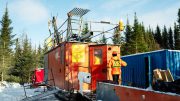It has been a story of evolution by discovery for Energizer Resources (EGZ-T), a Toronto-based explorer with significant land holdings in southern Madagascar. The company was originally billed as a prospective vanadium producer — its Green Giant property holds a 60-million-tonne resource grading 0.7% vanadium oxide — but chance intervened when Energizer discovered a series of graphite trends in late 2011, culminating in the unearthing of its newly minted flagship asset, the Molo deposit.
Flying into Energizer’s camp it is evident the company has been at work for a while. Its 30-person facility features air conditioning, wireless Internet access, a cell tower and 24-hour power. A rustic local town has expanded to the camp’s edge, and the well-tended dirt runway makes for a smooth landing after a three-hour, southbound flight from Antananarivo, Madagascar’s capital city.
The story began as a uranium play, according to Chairman and CEO Kirk McKinnon, before exploration efforts unveiled a volcanogenic massive sulphide (VMS) trend not unlike Nevsun Resources’ Eritrean assets, where Energizer senior vice-president of operations and vice-president of exploration Craig Scherba had been involved.
“Craig picked up on the compelling nature of the vanadium geology as exploration proceeded,” McKinnon comments. “We didn’t set out saying we’re going into the uranium, vanadium or graphite business, but when you’re dealt a good hand, you better play it.”
The graphite breakthrough didn’t come until Scherba’s geological pilgrimage to the University of Toronto, where technicians reassessed Energizer’s vanadium samples, and noticed an intriguing amount of the carbon allotrope. With new data in hand, Scherba returned to Madagascar and made exciting discoveries.
“We wanted to delineate what we thought was a graphite camp here, not just a deposit. We’re in a unique metamorphic environment, with amphibolite and granulite aspects that are key hosts to graphite mineralization,” Scherba says during a drive to Energizer’s Fotsy deposit. “You can’t just have metamorphic rock — you have to have extremely high temperatures to cook off all the volatiles. There aren’t that many places where you have those large, metamorphic terrains, plus the temperatures needed to create the sort of mineralized bodies we’re looking at now.”
The terrain is mostly flat. You can see for kilometres in any direction and navigate a four-wheeler over a sparse, flat savannah dotted with bursts of vibrant green, where broad-leafed trees have tapped a shallow, 15-metre water table to provide zebu herders and shepherds a shady respite from the midday sun.
Roadways sometimes more akin to broad cart tracks make for a bumpy ride, but a regional quarry transports 20-tonne stone blocks via daily truck loads to the port of Tulear 160 km northwest, Scherba points out, making the infrastructure sufficient for a graphite operation.
“Madagascar is basically a bit of a backwater right now,” McKinnon comments when asked about infrastructure. “As things move forward I think the country is going to get a lot more attention because all of a sudden, we have companies investing billions. That’s going to change things. And to be honest, I’d rather have that infrastructure and be in a savannah-desert style setting with no ecological issues, than deal with the prolific red-tape and cold climates you’d have in Canada.”
McKinnon is referring to Sherritt International’s (S-T) US$5.5-billion Ambatovy joint-venture nickel project in northern Madagascar, with major partners Sumitomo and Korea Resources. In addition, Thailand-based coal outfit Asia Pacific Mining is considering moving forward with a US$400-million development at its Sakoa coalfield 30 km northwest of Energizer’s camp.
“When we were originally looking at the vanadium project the capital costs were quite high, so we were really looking to create synergies with the Sakoa project to help with our economics,” Scherba says as he sweeps his hand across a regional map. “With the graphite we can operate independently with a lot more confidence. For example, where the coal operation needs to build an additional deepwater port to the south, we are able to use the existing port in Tulear for shipping. Quite literally we don’t need any additional infrastructure whatsoever.”
Energizer’s Green Giant graphite-vanadium play covers 1,057 sq. km of mineral concessions and 320 km of aggregate strike length. The company announced the discovery of flake graphite in early January following 3,800 metres of diamond drilling, 1,900 metres of trenching, and 670 regional prospecting samples.
Out of 2,155 mineral licences at Green Giant, 36 are 100% owned by Energizer and 2,119 licences fall under a joint-venture agreement with Australian partner Malagasy Minerals. Energizer holds a 75% stake.
Zeroing in on what it felt could be four mineable graphite deposits, Energizer crafted an exploration strategy to define which zone should be fast-tracked to development. The candidates included the Molo, Fotsy, Fondrana and Seta targets.
The runaway winner was the Molo deposit.
By the standards of the graphite world, Molo is impressive due to its potential size, grade and flake calibre.
Energizer unveiled a 330-metre-wide graphitic zone at surface during trenching activities, and for a visitor standing along the open trench, it is certainly impressive. The soil sparkles in bright sunlight, flakes of carbon mark outcrops and the dirt is dark and luminous.
Energizer confirmed Molo’s mineralization extends from surface to depths over 300 metres during initial resource drilling, when the company intersected 434 metres of carbon in hole 12-01 in early June.
Walking through knee-high grass in Molo’s central zone — also the target of the resource drill program — it is hard not to be struck by the deposit’s potential size. Scherba points out the trend continues to a ridge visible in the distance, and with depth established, it is not hard to imagine Energizer meeting its resource target of 80 to 100 million tonnes at grades between 6% and 10% carbon.
“What we’re trying to present to the market is an opportunity in regards to deposit size, as well as a location where you’re close to a lot of key consumers,” McKinnon says. “It’s not a question of having enough — it’s having a very good grade and having something that has the right metallurgy. On top of that it is ease of operations, where we have a deposit at surface with low strip ratios. The fact that we will be able to supply so much at competitive cash costs should give us an advantage.”
When McKinnon talks about metallurgy he’s referring to Energizer’s ability to achieve jumbo-flake graphite (+50 mesh) at 93% purity via simple crushing techniques. Large-flake graphite at purities exceeding 93% can sell for as much as US$3,000 per tonne. Typically graphite processing requires a flotation unit to reach marketable grades.
“Our biggest advantage is in the processing circuit right now,” Scherba explains, as he produces jumbo-flake graphite from Molo grab samples using a portable crushing unit in his lab. “Basically with the rock here, when you break it apart, the graphite will stay while the other material just crumbles away. So when you do the crushing process and send it through the sieves, the graphite stays on top and our jumbo- and large-flake graphite just comes out of that front-end process.”
In a bid to expedite Molo’s development, Energizer has partnered with South African
project manager DRA International, which has extensive experience operating in the region, having done work with majors like Anglo American (AAUKY-Q) and BHP Billiton (BHP-N).
“Given that this is a unique sector, an emerging sector and our unique insights and commitments, we think it is important to stay with it from a business-building standpoint,” McKinnon comments, when asked about Energizer’s lack of experience as mine developers. “It’s not our intention to necessarily apply our experiences to running a mine. It’s our intention to use DRA.”
The partnership involves DRA taking direct roles in project development, as well as facilitating infrastructure synergies with the Malagasy government and stakeholders in the nearby Sakoa coal project. Two experienced DRA engineers have joined Energizer’s board of directors — Johann de Bruin, who runs DRA’s business development department, and Robin Borley, a certified mine manager also involved at Sakoa.
The goal is to nail down a preliminary economic assessment by year-end and move onto feasibility work, with production targeted for late 2014. Scherba explains it may be possible to start-up an earlier pilot stage where Energizer runs a smaller-scale crushing operation to prove economic viability to the market. During initial testing DRA established it could achieve battery-grade graphite purity with chemical separation as the project expands.
Energizer realizes that having the flake size, supply and grades are important, but when it comes to the graphite market it is the end-user demand that can make or break a deal. The company believes the versatility of its deposits — containing jumbo-flake and amorphous smaller-flake graphite, as well as potential for battery grades — uniquely position it to meet demand from offtake partners at competitive cash costs. But McKinnon counsels caution and patience when dealing with such negotiations.
“I don’t think we necessarily have to be zeroing in on offtake agreements right now. There is definitely a chance you can do something too quickly with this sort of deposit. We need to touch all the important elements in the marketplace, all the known offtake opportunities,” he stresses. “We’re focusing on the U.S. at the moment, but we’ll be visiting Europe at the end of the month. I still think having Chinese partners or arrangements are essential because they are the ‘elephant,’ and aren’t going to let somebody — I don’t care how big your deposit is — come into the market and dominate it.”
China remains omnipresent in the graphite business, accounting for 80% of the world’s production, while also being the largest net importer. But there are signs that China’s reserves may be trending downwards. The country imposed a 20% export duty and 17% value added tax on the resource in an attempt to support its increasing domestic demand.
Speculation of supply shortages and incremental demand increases from new technologies like lithium-ion batteries, pebble-bed nuclear reactors and renewable energies have caused an exploration boom in the graphite sector, prompting a race to production that pits Energizer against juniors like Northern Graphite (NGC-V) and Focus Graphite (FMS-V), which have advanced-stage projects in northern Ontario and Quebec, respectively.
“There’s definitely a ‘graphite wave’ there, but not all of these deposits are going to make it into production, that’s just a fact,” McKinnon says. “We certainly have the quantities . . . a single graphite deposit with 100 million tonnes, and satellite deposits with anywhere from 20 to 40 million tonnes.”
Energizer feels its flake size, consistently high grades and growth potential give it a leg up on its competitors. Drilling at its nearby Fondrana deposit has hit highlights that include 6.24% carbon over 119 metres, 5.6% carbon over 66 metres and 5.3% carbon over 26 metres. Energizer’s Fotsy deposit has demonstrated similar potential with intersects of 12.2% carbon over 5 metres, 7% carbon over 12 metres and 5.2% carbon over 34 metres.
Energizer speculates that Fotsy and Fondrana could contain in excess of 25 million tonnes at 6.5% carbon grades, and remain open to further exploration if demand takes off. The company maintains a bevy of other regional targets that are ripe for further study.
Molo’s challenges involve project financing and offtake negotiations, as well as solidifying shareholder value in the face of volatile markets. Energizer maintains a relatively loose share structure, with 154 million shares outstanding and a 52-week range between 15¢ and 45¢.
McKinnon says his benchmark is getting to production without going beyond 200 million shares outstanding. The company has US$5 million in cash and marketable securities, so it should be able to avoid further dilution through Molo’s feasibility process. Energizer has bounced around in the 25¢ to 45¢ range over the past 12 weeks on 252,000-share average daily volumes. The company closed at 33¢ per share at presstime with a US$51-million market capitalization.
“Do I think our share price should be higher? Absolutely. Do I think it will get higher? Absolutely. The issue we have right now is that the market is pretty tight, and there is a lot of uncertainty,” McKinnon declares. “This is a time where if you have a unique opportunity and product, you can stand apart from the market. Uncertainty causes a lot of money to stand on the sidelines. If you can convince people that even though general investing isn’t attractive you have an opportunity to step above market volatility — they will listen. We think graphite has that ability.”





Be the first to comment on "Energizer puts Molo’s graphite in fast lane"